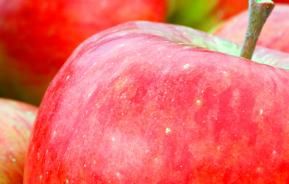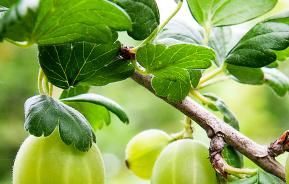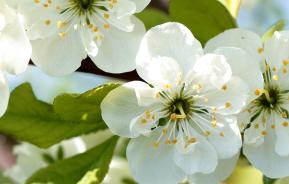When grown well, pears are succulent and juicy – so much so they’re best eaten in the bath so you don’t get covered in their juice! They are also highly ornamental thanks to their spring display of blossom.
Pears are also an easy tree fruit to grow at home. They are usually grown trained into half standards or, better still, bush trees, but they can also be trained into other shapes, such as espaliers and cordons along a fence or wall. These take up very little space – perfect for small gardens – so you don’t need an orchard to grow several varieties.
The easiest and quickest way to grow pears is to buy a young, ready-trained tree.
How to grow pears
Cultivating pears
Pears need a warm, sunny site, which isn’t too exposed – strong winds can reduce pollination by bees, leading to a poor crop. Always plant out of frost pockets, which again can reduce pollination.
They prefer a fertile soil enriched with lots of organic matter, which holds plenty of moisture in spring and summer, doesn’t dry out or become waterlogged.
Pear varieties
There may be several hundred varieties of pear, but your local garden centre or nursery will probably only stock a few of the favourite, best selling ones. First decide whether you want eaters (dessert varieties) or cookers, and then try to find out which varieties are local to your area – as they’ll probably be more suited to your soils and climate. Some of the most popular and commonly available are:
- Eaters/dessert: Beth, Concorde, Conference, Doyenne du Comice, Onward, Williams Bon Chretien
- Cooker: Catillac
- Dual purpose: Jargonelle, Shipover
To find out more about these and all the other varieties available, visit a good website, such as Orange Pippin or Frank P Matthews, where you will find descriptions and images of the fruit.

Rootstocks
Pear trees are available grafted onto different rootstocks, which control the overall size the tree will grow to, as well as how early in its life it starts fruiting. The two most common ones are shown below. The eventual size will vary, depending on your soil; on heavy clay and fertile soils the trees will grow bigger.
- Quince A Semi-dwarfing: The ideal root stock for bush trees and espaliers; produces a tree of 3-4.2m (10-14ft)
- Quince C Dwarfing: Slightly earlier into cropping and best for cordons; produces a tree of 2.4-3m (8-10ft)
Pollinating pears
Some pear varieties are self-fertile and will produce fruit without growing another compatible variety close by. These are the best ones to choose if you only want 1 tree or only have room for 1 and include ‘Concorde’, ‘Conference’ and ‘Williams Bon Chretien’.
Other, non self-fertile varieties will need to be grown close to another different pear variety that flowers at the same time to help pollinate it and produce good crops of fruit. Even those described as self-fertile will crop much better if there are other suitable varieties growing nearby.
In most urban neighbourhoods another suitable tree should be within bee flying distance for this not to be a problem. In isolated gardens another variety from the same or adjoining pollination group will be needed for heavy cropping.
Planting pear trees
Plant bare-root trees between November and March, and container-grown ones preferably in autumn, winter or spring.
Dig a hole 60x60cm (2x2ft) and 30cm (12in) deep. Add a layer of organic matter – such as compost or well-rotted manure – to the base of the hole and dig in. Place the roots of the tree in the planting hole and adjust the planting depth so that the old soil mark on the trunk is level with the soil surface.
Now mix in more organic matter to the soil and fill in the planting hole. Stake the tree with a rigid tree stake and two tree ties so that it is fully supported against the prevailing winds. Water in well, apply a granular general feed over the soil around the tree and add a 5cm (2in) deep mulch of well-rotted garden compost or bark chippings around the root area.Large patio pots (minimum of 40-50cm/16-20in in diameter) can be used to grow pear bush trees. Use John Innes No 3 Compost with soil for pears trees, as its weight will help with stability.
How to care for pears
Once established, pear trees are unlikely to need regular watering, except in extreme drought conditions. But watering during fruit set will help ensure a bumper crop.
Trees growing in containers, however, will need regular watering in spring and summer to prevent the compost drying out.
Add a controlled-release or granular plant food to the soil surface each spring to ensure the tree is fed throughout the growing season. Then mulch the soil with well-rotted manure, garden compost or bark chippings
Pruning pear trees
If you buy a fully trained tree, pear trees need little in the way of pruning for the first few years. Beyond that, it pays to know what, how and why you’re pruning, as wrong or excessive pruning can lead to crop reduction. Most times all you need to do is remove dead, diseased, dying or damaged branches, branches that rub against each other and those that cross from one side of the tree to another.
If you constantly have to prune the top of the tree to reduce its height, then you’ve probably bought one growing on the wrong rootstock!
Pruning pear trees is pretty simple if you know a few basic rules:
- Free-standing trees: Prune in winter (December/January). Cut shoots back to about 4 buds to encourage new flowering and fruiting spurs to develop. Thin out excess spurs.
- Trained trees (espaliers, cordons and pyramids): Prune in late summer, when the new growth is cut back to 2 buds. They may benefit from a second prune in winter, when some of the older spurs can be thinned out.
Thinning fruit
Pears tend to thin themselves by dropping some of their fruit in early summer, known as the ‘June drop’. Pears can be prone to producing too much fruit, but don’t usually need much thinning. If it is necessary, thin clusters to 2 fruit, 10-15 cm (4-6in) apart.
Harvesting pears
You should harvest pears just before they are fully ripe, otherwise they soon become too soft and inedible. They should be firm, with a colour change to their skin. You can test early varieties by tasting for sweetness. To check if later varieties are ready to harvest, gently cup one with your hand, lift, and lightly twist. It should come off in your hand reasonably easily with the stalk attached.
Pears benefit from a period of ripening before eating. Early varieties usually only need a week or so, whereas later varieties may need a month or so.
Store fruit in a dark cool place with good ventilation. Place in a well-ventilated or slatted box, spaced out so air can circulate between the fruit. Check regularly and remove any that are rotting.
| Flowering season(s) | Spring |
|---|---|
| Foliage season(s) | Spring, Summer, Autumn |
| Sunlight | Full sun |
| Soil type | Chalky, Clay, Loamy, Sandy |
| Soil pH | Neutral |
| Soil moisture | Moist but well-drained |
| Ultimate height | Up to 4.2m (14ft) depending on rootstock |
| Ultimate spread | Up to 1.8m (6ft) depending on rootstock |
| Time to ultimate height | 5-10 years |








